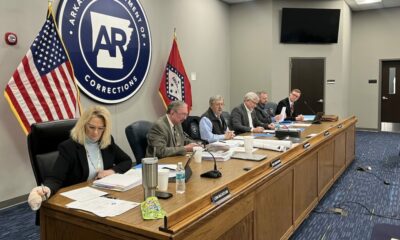Mississippi Today
Mississippi spends less on college grant aid than nearly every Southern state

Mississippi spends less money on college financial aid programs than almost every state in the Southern region.
This holds true for both total dollars spent in Mississippi – about $45 million – and the average amount of grant money each college student receives. Other states, including deep-red neighbors Arkansas and Louisiana, dole out more money for college on a per-student basis while charging roughly the same or less for tuition. Even West Virginia, with close to half of the population, spends double Mississippi.
Not many lawmakers today know why this is, but several factors may be the cause: Financial aid policy is complex, and the Legislature tries to keep tuition low through funding the colleges and universities. Plus college financial aid is not a core function of government, many lawmakers say, such as roads and bridges or paying teachers.
But a change may be underway this legislative session. Amid increased interest in workforce development — not to mention Mississippi’s $700 million surplus — lawmakers are no longer asking the state’s financial aid office to make its programs less expensive.
Instead, they want to know: If Mississippi spends more, what will we get for it?
“If you look at it, that student, their life is an economic development project,” said Sen. Daniel Sparks, R-Belmont. “If we can get them from $26,000 to $66,000 a year (in income), that’s the most important economic development project in that person’s life.”
Earlier this week, the agency responsible for Mississippi’s college financial aid programs presented its new proposal to the Senate Colleges and Universities Committee that would pump $30 million into adult, part-time and many low-income students who, by law, have been ineligible for the Mississippi Resident Tuition Assistance Grant since it was created nearly three decades ago.
Depending on family income, an estimated 37,000 students would get an additional $500 to $1,000 toward the cost of tuition. And, unlike past proposals, this one would be enacted without cuts to the only state grant program that helps low-income students pay for college. It has already passed the House Colleges and Universities Committee.
The main question posed during the Senate meeting is how will Mississippi benefit from the increased funding. Though Mississippi’s overall investment in financial aid would remain low, the proposal’s price tag would nearly double what the state spends on helping students afford college, surpassing Alabama.
“Do we have metrics?,” asked Sen. Bart Williams, R-Starkville. “Can we show an ROI (return on investment)? We’re talking … about all this including everybody. What are we getting from it?”
There is no data, responded Jennifer Rogers, the director of the Mississippi’s Office of Student Financial Aid. Lawmakers have never required performance-based funding for the programs she administers.
But the research on state financial aid spending is clear.
What research shows on college aid spending
Though not a cure-all, financial aid programs pay off in all the areas lawmakers want to tackle this session: College-going and completion rates, career-readiness and workforce development.
In general, college financial aid of any kind increases graduation rates. In Mississippi, research requested by OSFA found all three grant programs increased college graduation rates.
But exactly how much is typically a function of a student’s income.
Because higher education costs money, financial aid that goes to students from families who can’t afford to pay for college on their has been shown to yield greater results, said Tom Harnisch, the vice president for government relations at the State Higher Education Executive Officers Association. It can be the difference between these students finding time to be involved on campus or working second jobs to pay for rent.
“Those are the students that are really going to move the dial,” Harnisch said.
For every $1,000 of grant aid spent on low-income students, research has shown college retention rates increase between 1 and 5%. In Florida, an additional $1,300 in need-based aid increased six-year graduation rates by nearly a quarter. In Texas, a grant program for low-income students was found to have freed 75 to 84 hours they would have spent working their first two years. For first-time students who receive a full federal Pell Grant, each additional $1,000 increase in grant aid is associated with more than $1,000 increase in earnings four years after enrollment.
When states spend more on financial aid, more students pursue higher education. Community colleges in particular see an increase in enrollment.
Sandy Baum, a nonresident senior fellow at the Urban Institute who has studied Mississippi’s financial aid programs, said the new proposal would be an improvement on MTAG’s current structure because it would direct more dollars to students who can’t afford to pay for college on their own.
“Of course Mississippi needs to spend more,” Baum said.
Other states have dramatically increased financial aid spending, the Urban Institute has found. After Arkansas legalized a lottery in 2008 and used it to fund college scholarships, the state’s spending on financial aid increased by $100 million.
So why hasn’t Mississippi?
A longstanding preference for less-expensive merit aid programs may be a reason.
Mississippi’s best and brightest
When lawmakers created MTAG in 1995, their goal was to help middle-class students afford college. The legislation was championed at a pivotal time by Eddie Briggs, the first Republican lieutenant governor in Mississippi since the Reconstruction era. To this day, the grant primarily benefits Republicans’ traditional constituents: White, middle-class Mississippians.
“This program will help to keep Mississippi’s best and brightest here at home,” Briggs wrote in an op-ed at the time.
Two years later, lawmakers created the state’s Higher Education Legislative Plan for Needy Students. But unlike MTAG, which lawmakers were required to fund from one year to the next, HELP was available only if the money was. In the program’s first year, Mississippi budgeted just $500,000 for HELP but spent $900,000, a fraction compared to MTAG’s $12 million.
Today, HELP is the most expensive grant program, because it pays for all four years of college. Of the three, it’s also the most effective at what it was created to do. And yet it benefits the fewest Mississippians: Just 4,538 students received HELP last year, less than a third that received MTAG.
Mississippi’s spending on college financial aid is also tied to state revenue, said Sen. Briggs Hopson, R-Vicksburg, the chair of the Senate Appropriations Committee who in 2018 led discussions to change Mississippi’s grant programs.
Adequate funding of the colleges and universities, Hopson said, helps keep tuition low.
“It is an overriding theme that we want to keep our colleges affordable, and I think we are,” he said. “It’s always a moving target.”
With this latest proposal, lawmakers’ tune may be changing on need-based aid as Mississippi’s colleges and universities, teetering on the edge of a demographic shift that will mean fewer high school graduates go to college, need more students in seats.
And, there’s an increased push for workforce development programs, which have been called the “message of the day” in Jackson.
Sparks, senator from Belmont, said he would like to see changes to MTAG encourage people to pursue well-paid careers. He liked that last year’s proposal offered a bonus for students to major in certain subjects deemed “high-value pathways” by the state’s workforce development office. That seemed like a way to ensure the spending has a return-on-investment, Sparks said.
“I don’t want to get into choosing what you (students) go take,” Sparks said. “But on the other hand, if I’m looking for someone else to pay the way or pay a portion of the way, they’re going to have more input than if I went in and said, ‘I got this myself.’”
Universities v. community colleges?
As with last year’s bill, this proposal is likely to come down to a tug-of-war between universities and community colleges.
During the Senate meeting, Hopson asked if the extra dollars might be better spent in direct appropriations to the public institutions considering the new program would also benefit Mississippi’s private colleges.
“If we put $31 million into Kell (Smith)’s budget or into Al Rankin’s budget, they’d probably say give me the $31 million,” Hopson said. “But the private colleges would probably like this better because they’re going to get some part of this.”
Hopson asked if it would be possible to instead ask the public colleges and universities to use the additional funding for institutional scholarships. Rogers replied that money “doesn’t always trickle down.”
“I think probably you know exactly what their response is going to be,” Rogers said. “But I guess, from my perspective, someone has got to stand up and fight for the students who are facing a huge affordability puzzle.”
This article first appeared on Mississippi Today and is republished here under a Creative Commons license.![]()
Did you miss our previous article…
https://www.biloxinewsevents.com/?p=334301
Mississippi Today
Government secrecy tends to bite Mississippi in the butt. It’s happened again
The state Senate Republican leadership didn’t plan to fail on a Mississippi tax overhaul. It failed to plan.
And when pressed late in the 2025 legislative session to come up with a proposal to counter the House Republican leadership’s sweeping bill, Senate leaders did so behind closed doors and hurriedly.
The result: a majority of legislators passing a tax overhaul bill full of math errors that accidentally did what Senate leaders didn’t want. And it stripped out safeguards for taxpayers that both the House and Senate leadership said were prudent.
No matter how much Gov. Tate Reeves praises House Bill 1 as “one big, beautiful bill,” borrowing a phrase from President Trump as he signed it into law, it was passed through secrecy, subterfuge and error, not representative democracy.
Had the Senate perhaps taken a little more time, allowed more input from and access to its strategizing from rank-and-file lawmakers, and who knows, maybe even a little crowd-sourcing allowing the public to scrutinize the bill before passing it, maybe the blunder could have been prevented.
READ MORE: OOPS! Senate sent House an income tax bill with typos. House ran with it. What’s next?
And while House leaders should receive praise for coming up with an initial public-facing tax overhaul plan through months of public hearings and forums, that’s not what was passed into law. House leaders played a game of secret squirrel to pass the Senate’s mistakes into law. Then instead of negotiating in good faith to fix the problems, House leaders tried to shanghai the Senate in backroom negotiations to pass a few plums they wanted, such as legalized online sports betting and a sales tax increase.
The end result: Historically bitter infighting among state GOP leaders to the point they couldn’t even pass a state budget, their main job. And we have communications between Mississippi’s top legislative leaders and governor, all Republicans, that these days are often reduced to mean tweets or Facebook posts about each other, not earnest negotiations.
READ MORE: The Typo Tax Swap Act of 2025 may be the most Mississippi thing ever
Mississippi government’s default setting is secrecy, from public records and meetings to access to elected officials, and it has never served our citizens well. From a black-ops agency that spied on its citizens for nearly two decades to festering, generational government corruption that has cost taxpayers hundreds of millions of dollars, secrecy is neither good politics nor good policy.
Major, sweeping state policy should be conducted in the open and with public input. But as the national and world economies plunge into turmoil that is sure to impact Mississippi, our new tax code lacks safeguards that both House and Senate leaders said were needed — all because of secrecy and lack of planning and communication.
This article first appeared on Mississippi Today and is republished here under a Creative Commons Attribution-NoDerivatives 4.0 International License.
Mississippi Today
Ward 6 council candidates face the image of south Jackson versus the reality
Driving down roads in south Jackson in recent weeks, residents were inundated with placards of smiling faces and names in bright, bold fonts of people hoping to be the next Ward 6 councilman.
In some neighborhoods, the streets were as littered with campaign signs as they are overgrown lots and abandoned properties in between neatly kept homes.
“The homes in the surrounding area and businesses in Ward 6 have been decimated. It looks like a bomb went off,” said Sylvia Walker, Ward 6 board member for the Jackson Association of Neighborhoods. “We’ve seen the businesses hollow out and nothing come back in. It’s disheartening. It’s sad.”
Walker said the image of south Jackson must be interrogated. Not enough people are talking about the good happening in Ward 6, she said.
“South Jackson is very diverse and not just one specific area,” said Walker. “I think the biggest misconception is that south Jackson is just full of dilapidated homes, and the people are poverty-stricken and destitute, and that’s not true.”
Ward 6 has the largest population of Jacksonians, with just over 23,000 people. It also has the highest number of Black residents, according to data from the City of Jackson’s website.
Jackson also has a high number of abandoned properties owned by the state. According to data from the Secretary of State’s office, there are about 1,900 tax-forfeited properties in the City of Jackson.
There will be a Democratic runoff on April 22 between two candidates for the Ward 6 city council seat. Emon Thompson Sr. garnered 714 votes and Lashia Brown-Thomas came in second with 652 votes. Voter turnout was low, with less than 3,200 votes cast in a ward with a voting age population of more than 16,000. There were nine contenders for the coveted council seat, more than any other council race.
Candidates for the coveted Ward 6 seat envision a more beautiful, thriving south Jackson. After a stacked primary, two candidates have made it to the runoff to replace Aaron Banks, former council person who faces criminal charges for allegedly accepting cash bribes in exchange for his vote on a development project. He pleaded not guilty.
Banks is familiar with the image problem in south Jackson. He said he’s made progress with more demolitions and landscaping work done than others in the past. This includes the demolition of Casa Grande Apartments and Appleridge Shopping Center.
“I’ve always said that I would serve two terms, and we got a lot of work done,” Banks said in a recent interview with Mississippi Today.
Brown-Thomas said that crime and blight are the biggest issues affecting Ward 6. The law enforcement officer wants to hold people accountable for their part in the perceived image of a decaying south Jackson.
“The city has codes, and if these people are not holding up to the codes, they need whatever punishment there is,” Brown-Thomas said. “If they aren’t holding the property up, then they should not have the property.”
She said that if she’s elected, she’ll work to get police officers higher wages, and will remain transparent and available to constituents.
“It’s not going to happen overnight, but it will take some time,” Brown-Thomas said. “I’m not saying it’s going to come in a year, not even two years, but we have to address the issues first, then everything else will fall in line.”

Thompson Sr., a business owner and retired veteran, said that a lot of the issues with blight comes down to enforcement.
“We need to, first of all, clean up our blighted properties by using the laws that we already have,” Thompson said. “The city already has ordinances with enough teeth to deal with blight.”
South Jackson voters don’t turn out like they should, he said, which can lead to a distrust in the system. He hopes, if elected, to be able to reach constituents where they are and keep them a part of the process in restoring their communities, like water improvement or curbing crime.
“Out of the 40 something thousand people that’s in south Jackson, maybe 3,900 people vote in the municipal elections,” he said. “They don’t have faith in the government anymore.”
“…If there’s a reason why we’re not getting any services out here, then I want to make sure I communicate that with a constituent so they can continue to have hope,” he said.
Representative Ronnie Crudup, Jr., D-Jackson, said that residents’ migration out of Jackson creates bigger issues for communities.
“To me, blight is just a symptom of a larger problem. The people are leaving the city of Jackson, and the population is decreasing,” Crudup said. “When people leave the properties, you end up with squatters and vagrants who move into these properties and tear them up.”
Crudup has been renovating and demolishing blighted properties in south and west Jackson for nearly eight years. So far, he said he’s renovated about 35 homes.
“Even though we are demoing and tearing down one or two properties, when people leave, that leaves other ones there,” he said. “You got all these blighted properties all around south and west Jackson, and some even in parts of north Jackson now, because people are leaving.”
He said the one thing that’s needed most: more funding from all levels of government for blight mitigation work.
“There needs to be more money from the legislature, but there needs to be more money allocated from the city council too,” Crudup said. “I think the city is going to have to take clean up efforts to a higher circumstance, and let the legislature see that they’re serious about this, and also get the county involved and let them know ‘Hey, we need all the help we can get.’”
And, the perception that city leaders have abandoned south Jackson is not necessarily right. Former Jackson Mayor Harvey Johnson said that blight is an issue that affects not only south Jackson but all parts of the city. Mitigating blight is going to take an intergovernmental approach, he said.
“I know that in some cases, some people feel they’ve been sort of abandoned, but I don’t think that’s the case,” Johnson said. “It may be a lack of resources to attack the problem and it’s going to require all governments to work together.”
Walker said she remembers when the city’s southern boundary changed and her neighborhood, which had been part of Byram, came inside Jackson city limits. A small portion of her ward was annexed by the city of Jackson in 2006 as part of Byram’s reincorporation. In the last couple of decades, she said she’s seen people be forced out of their homes due to the recession. Others simply chose to leave.
“We’ve had a turnover, but the neighborhood is still relatively stable,” Walker said. “When we moved in, a lot of people moved out.”
Walker said that while her neighborhood isn’t struck by blight, she sees abandoned properties while making her way through the community and near her church.
When thinking of a candidate that she would want to vote for, Walker said she’s looking for a good communicator who can be an advocate for the ward.
“We need someone that’s forward thinking. Someone that has the best interests of the residents of south Jackson and an understanding of the vast diversity of the ward,” she said. “Someone that’s able to work with other members of the City Council. Someone able to work with our board of supervisors and state legislators to find solutions to some of these issues.”
Banks said that his greatest achievement as city councilman was hosting quarterly town hall meetings to inform his constituents on the importance of ordinances and legislation created to better their lives.
“There’s one piece of legislation that deals with overhanging tree limbs and limbs. That idea came from a constituent,” he said. “When you see constituents being able to give informed ideas on legislation, which is the job of a council member, I think that’s an achievement because then what that says is there’s involvement in the process.”
“I hope the next person will understand that communicating with the people is key, and that the people of Ward 6 are resilient,” Banks said. “As long as they continue to communicate and stay in the scope of their job and work with the administration, there’s a lot that can be done.”
This article first appeared on Mississippi Today and is republished here under a Creative Commons Attribution-NoDerivatives 4.0 International License.![]()
Mississippi Today
On this day in 1962, white cop killed Cpl. Roman Ducksworth
April 9, 1962

Cpl. Roman Ducksworth Jr., a 27-year-old Black military police officer stationed at Fort Ritchie, Maryland, was traveling home by bus to Mississippi. His wife, Melva, was expecting their sixth child and was now in the hospital because of complications.
By the time he arrived home in Taylorsville, Mississippi, he had fallen asleep. The driver called William Kelly, a white police officer onto the bus to wake him. Kelly instead arrested the serviceman, claiming he was drunk.
Off the bus, the two struggled, and the officer shot twice, striking Ducksworth in the chest. He died without knowing his wife had just given birth to a healthy baby girl. Kelly claimed he shot Ducksworth in self-defense, and he was never prosecuted.
Later he sent a message to Ducksworth’s father: “If I’d known it was your son I wouldn’t have shot him.” The father replied, “I don’t care whose son it was, you had no business shooting him.”
More than 2,000 attended the funeral for Ducksworth, who was buried with full military honors, including a 16-gun salute by an integrated honor guard. He is among 40 martyrs listed on the Civil Rights Memorial in Montgomery, Alabama.
This article first appeared on Mississippi Today and is republished here under a Creative Commons Attribution-NoDerivatives 4.0 International License.![]()
-

 News from the South - South Carolina News Feed6 days ago
News from the South - South Carolina News Feed6 days agoSouth Carolina clinic loses funding due to federal changes to DEI mandates
-

 The Center Square6 days ago
The Center Square6 days agoCA fails audit of federal programs, 66% of COVID unemployment benefits in question | California
-

 News from the South - Arkansas News Feed6 days ago
News from the South - Arkansas News Feed6 days agoArkansas prison board approves contractor search for Franklin County prison
-

 News from the South - Alabama News Feed6 days ago
News from the South - Alabama News Feed6 days agoAlabama House passes public school cell phone ban
-

 News from the South - Georgia News Feed7 days ago
News from the South - Georgia News Feed7 days agoBond hearing for man accused of murdering pregnant ex | FOX 5 News
-

 News from the South - Alabama News Feed4 days ago
News from the South - Alabama News Feed4 days ago‘Hands Off!’ Protest Held in Huntsville Saturday | April 5, 2025 | News 19 @ 9 P.M.
-

 News from the South - Kentucky News Feed7 days ago
News from the South - Kentucky News Feed7 days agoTornado likely behind heavy damage in rural Taylor County, officials say
-

 News from the South - Oklahoma News Feed6 days ago
News from the South - Oklahoma News Feed6 days agoRetired Cops Sound Alarm on Pension Board Shift













































